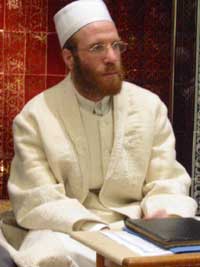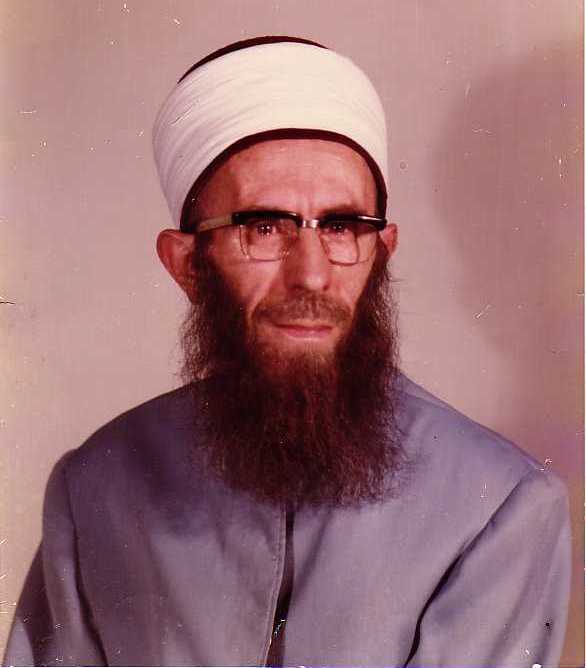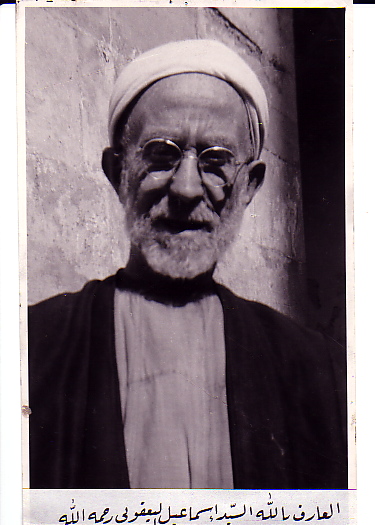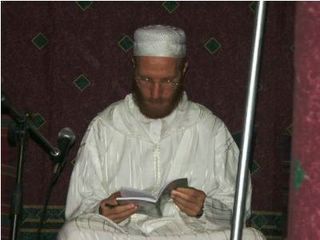The Ya`quby family
| Sheikh Muhammad al-Ya`qubi o Biography o Presentation /swedish/ o Poetry o Orbituary to his late wife Fariza o More pic's o Video o Extra... Sheikh Ibrahim al-Ya`qubi o Biography o Poetry |
 |
 |
 |
| Sheikh
Muhammad (b. 1382 H./1961 CE) |
Sheikh
Ibrahim
al-Ya`qubi (d. 1406 H./1985 CE) |
Sheikh
Isma`il
al-Ya`qubi (d. 1380 H./1960 CE) |
|
Shaykh
Muhammad
al-Ya`qoubi - biography
Shaykh Muhammad
al-Ya`qoubi
descends from a scholarly family whose
lineage goes back to the Prophet, salla Allahu 'alayhi
sallam, through
his grandson Sayyiduna al-Hasan, radiya Allahu 'anhu.
His lineage goes
back to Mawlay Idris al-Anwar who built the city of Fes.
Mawlay Idris'
lineage is as follows: he is the son of Mawlay Idris the
Great; who is
the son of Sayyiduna Abdullah al-Kamil; who is the son
of Sayyiduna
al-Hasan, the Second; who is the son of Sayyiduna
al-Hasan, radiya
Allah 'anhu; who is the grandson of the Prophet, salla
Allahu 'alayhi
wa sallam.
Shaykh Muhammad al-Ya'qoubi's ancestors also include some of the greatest scholars of Syria: Shaykh Sharif al-Ya'qoubi (d. 1943/1362 H.) was his father's uncle, and Shaykh Muhammad 'Arabi al-Ya'qoubi (d. 1965/1384 H.) was his father's maternal uncle; both were the Malikite Imams of the Omayyad mosque. Shaykh Siddiq al-Ya'qoubi (d. 1889/1307 H.) was his paternal great-grandfather, and Shaykh Isma'il al-Ya'qoubi (d. 1960/1380 H.), a great Waliy known for his miracles, was his own grandfather. His father, Shaykh Ibrahim al-Ya'qoubi (d. 1985/1406 H.), was one of the greatest scholars Syria saw in the past 50 years; he was also the Imam and teacher of the Omayyad Mosque.
Shaykh Muhammad was born in Damascus on the 13th of DhulHijja in 1382 H. As a little boy, he crawled in the Grand Omayyad Mosque and the Darwishiyya Mosque, where his father was an instructor for 40 years, and sat in the laps of some of the greatest scholars. Since he was four-years-old, Shaykh Muhammad accompanied his father in all of his visits, gatherings, and classes, both public and private, as well as at home and outside. His father took care of him and was both his teacher and spiritual master. Under his tutelage, Shaykh Muhammad followed a solid traditional curriculum since the age of four, studying, step-by-step, the major classical works on the various disciplines of the Shari'ah as well as the instrumental disciplines. Shaykh Muhammad dutifully studied with his father over 500 books in the course of 20 years, some of them from cover-to-cover and others in portions; some are multi-volumes, and others are small concise works.
Some of the books Shaykh Muhammad studied under his father are as follows: most of the six books of Hadith, al-Muwatta of Yahya al- Laythi, most of al-Muwatta of Imam Muhammad with Sharh al-Laknawi, most of al-Muwaafaqaat of ash-Shaatibi, the first volume and other sections (of the five volumes) of al-Hashiya of Ibn 'Abideen, Ihya 'Ulum ad-Deen, al-Hidaya of al-Marghinani, Mughni al-Labeeb of Ibn Hisham, Parts of Kitab Seebawayhi, Miyar al-Ilm of al-Ghazali, several volumes of Sharh Sahih Muslim of an-Nawawi, several volumes of Irshad as-Saari of al-Qastallaani, half of Madarik at-Taweel of an-Nasafi, Hashiyat as-Saawi on Tafseer al-Jalaalayn, three volumes of Mu'jam Maqaayiis al-Lugha of Ibn Faaris, al-Bayaan wat-Tabyeen of al-Jaahiz, several volumes of Wafayaat al-Ayaan of Ibn Khallikaan, and Tabaqat ash-Shafi'iyya al-Kubraa of Ibn as-Subki, Maqamaat al-Hariri. In fact, Shaykh Muhammad wrote a thabat (detailed list) of the names of the books he studied under his father entitled, The Concealed Pearls. This book is a testament to his father's labor of love and of the expenditure of his energy in passing on his knowledge and experience to his children, a rarity in our modern times.
Throughout the years of his study, Shaykh Muhammad went through spiritual training in the Sufi path under his father, who was a great Waliy and Murshid known for his righteousness and asceticism. Shaykh Muhammad studied the major works of Tasawwuf under him, accompanied him, and was his servant, the bearer of his shoes, which he considers the key to the opening he received. The company of his father exposed him to a wealth of light, wisdom, and knowledge, an experience that was far beyond what one may attain from books or from occasional meetings with teachers.
In the summer of 1973, at the age of eleven, Shaykh Muhammad started teaching at the Darwishiyya Mosque where he taught a regular Qur'an and Tajwid class composed of a group of boys. He began giving public speeches in Ramadan after 'Asr prayer in the same mosque at the age of twelve. At the age of fourteen and a half, he made his debut as Friday speaker in the mosque known as as-Saadaat, where Sayyiduna Mu'aadh ibn Jabal is buried.
Shaykh Muhammad memorized Jawharat at-Tawhid when he was five-years-old, al-Arba'in an-Nawawiyya when he was six, and, later on, dozens of famous didactic odes and poems along with most of the Qur'an al-Karim. He also memorized considerable parts of al-Mufaddaliyyaaat and al-Hamaasah of Abi Tammaam. The first poem he wrote was at the age of thirteen, and it was a plea to the Prophet salla Allahu 'alayhi wa sallam. His collection of poetry is growing, and a few poems in English have been added to it.
Amongst the scholars who gave him ijaza (the authority to narrate Hadith through their chains) were the Malikite Mufti of Syria, Sayyid Makki al-Kittan; Shaykh Muhammad Abul-Yusr 'Abideen, the previous Mufti of Syria; the great Murshid, Shaykh Ali al-Boudaylimi of Tlemsan; Shaykh Zayn al-'Abideen at-Tounisi; Shaykh 'Abdul'Aziz 'Uyun as-Soud; Shaykh Muhammad Wafa al-Qassaab; and several others. Shaykh Muhammad's father, may Allah shower him with His Mercy, also wrote several ijazas for him, giving him full authority to narrate Hadith. His father also issued for him ijazas qualifying him to teach the Shari'ah and to be a Murshid in the Sufi path. This was affirmed by several shaykhs of the path, the last of whom is Shaykh AbdurRahman ash-Shaghouri in Damascus, may Allah extend his life.
Shaykh Muhammad published his first article when he was seventeen-years-old in al-Majalla al-'Arabiyya in Riyadh and his first book when he was 23. At the age of 20, some of his Friday speeches were broadcast live through the Syrian Radio station. Three of his books in Arabic have been published besides several articles in Arabic, English, and Swedish. The list of his unpublished books contains more than 20 works in Arabic.
Shaykh Muhammad was formally appointed as Friday speaker (khatib) in 1981 in central Damascus. Two years later, in 1983, he was appointed as Imam and was commissioned to teach the Sacred Knowledge. In early 1986, upon the demise of his father (may Allah have mercy on him), Shaykh Muhammad was given his father's post as an instructor in the Fatwa Administration. That same year, he began teaching Maliki fiqh at the Institute of the Students of Sacred Knowledge (which is now the Institute of Sheikh BadrudDeen al-Hasani).
While in Damascus, in addition to teaching native Syrians, Shaykh Muhammad taught students from various parts of the world; many of them are now Imams and teachers in Malaysia, the Philippines, Algeria, Mali, Gambia, and other countries. Amongst the books he taught, partially or completely, are Sahih al-Bukhari (which he taught twice), Sahih Muslim, al-Muwatta (which he also taught twice), ash-Shama'il al-Muhammadiyya (which he taught four times), the commentary of al-Bajuri on al-Jawhara, an-Nasafi's Madarik at-Tawil, Jawahir al-Iklil Sharh Mukhtasar Khalil, al-Kaafi of Ibn AbdulBarr, al-Hikam of Imam ibn Attaa Allah, Sharh ar-Risala of Imam al-Qushayri, al-Marghinani's al-Hidaya, Sharh al-Bayqouniyya, Sharh ar-Rahabiyya, Sharh al-Jazariya, ash -Shifa of Qadi 'Iyaad, and Ibn Hisham's commentary on the Alfiyya of ibn Malik.
Besides serving as a Friday speaker and instructor until 1990, Shaykh Muhammad pursued his academic studies at the University of Damascus, Faculty of Shari'ah, where he frequented some lectures and benefited from several professors between 1982-1985. He also received a degree in Arabic literature in 1987 and completed a two-year study of philosophy at the Arab University of Beirut. In 1991, Shaykh Muhammad joined the PhD program of linguistics at Gothenburg University in Sweden, Department of Oriental Studies, where he also worked as a researcher and a teacher of classical Arabic literature for a few years until 1996.
Shaykh Muhammad worked in Dar al-Athar al-Islamiyyah in Kuwait in 1990 as Research Editor, and, between 1998-1999, as Assistant Director for Research and Studies, a position he was awarded due to his keen interest in the studies of ancient Arabic manuscripts and paleography. He eventually resigned to devote his time to the Sacred Knowledge and to serve its students in teaching and writing.
While in school, Shaykh Muhammad studied French as a second language. It was in 1988 that he began learning the basics of English and German. At the age of 30, upon traveling to Sweden, he realized how vital is the English language in the work for Islam, so he moved to England at that time and completed the FCE, CAE, CCS, and CPE Cambridge courses in English within a year before returning to Sweden where he continued his studies in Swedish.
In Sweden, Shaykh Muhammad served the Muslim community of Gothenburg as Imam, where he struggled for the establishment of Islam in the country. His work there was documented in several newspaper articles and interviews; it included teaching Muslims, giving presentations about Islam, and engaging in multi-religious dialogues and debates on political and social issues, such as European-Islamic dialogue, atheism, etc.. Shaykh Muhammad was hosted by all of the major Swedish universities and Institutions and was co-founder of the Nordic Center for Inter-religious dialogue (NCID) in Gothenburg. He represented Swedish Muslims in several international conferences until he returned to Syria towards the end of 1996. In 1999, the Swedish Islamic society in Stockholm (SIS) chose him as the Mufti of Sweden, forwarding to him the burning issues of fiqh that concern Swedish Muslims. In the year 2000, SIS elected him as a permanent founding member of the Swedish Islamic Academy in Stockholm in recognition of his work in Sweden to which he continues to commit through lectures and classes during his visits to Scandinavia.
Besides working in Syria and Sweden, Shaykh Muhammad participated in conferences, delivered lectures, and gave Friday speeches in Lebanon, Egypt, Jordan, Kuwait, Saudi Arabia, Algeria, Denmark, Finland, Norway, Switzerland, Germany, France, Spain, England, Canada, and the United States. His first tour to the US took place in the spring of 1997. Since then, he has been frequenting North America and is now hosted by Zaytuna Institute in California where he has been teaching since the past year. In his efforts to revive the Tradition, he has taught Hadith, including the Muwatta' and Sahih al-Bukhari, and he intends to finish all six books in the coming terms in sha Allah. Shaykh Muhammad is married and has three children, Aicha, who is four; Ibrahim, who is two; and Ismael, who is four-months-old.
Others besides Shaykh Muhammad have seen many of the miracles of his father, but for those who have not seen them, Shaykh Muhammad says, "This is one of the miracles of my father that everyone can see. It was his du'ah for me, his blessing, and his company that opened the way for me to be where I am now."
(Source: Sheikh Ibrahim Institute http://shaykhibrahiminstitute.org/)
Shaykh Muhammad al-Ya'qoubi's ancestors also include some of the greatest scholars of Syria: Shaykh Sharif al-Ya'qoubi (d. 1943/1362 H.) was his father's uncle, and Shaykh Muhammad 'Arabi al-Ya'qoubi (d. 1965/1384 H.) was his father's maternal uncle; both were the Malikite Imams of the Omayyad mosque. Shaykh Siddiq al-Ya'qoubi (d. 1889/1307 H.) was his paternal great-grandfather, and Shaykh Isma'il al-Ya'qoubi (d. 1960/1380 H.), a great Waliy known for his miracles, was his own grandfather. His father, Shaykh Ibrahim al-Ya'qoubi (d. 1985/1406 H.), was one of the greatest scholars Syria saw in the past 50 years; he was also the Imam and teacher of the Omayyad Mosque.
Shaykh Muhammad was born in Damascus on the 13th of DhulHijja in 1382 H. As a little boy, he crawled in the Grand Omayyad Mosque and the Darwishiyya Mosque, where his father was an instructor for 40 years, and sat in the laps of some of the greatest scholars. Since he was four-years-old, Shaykh Muhammad accompanied his father in all of his visits, gatherings, and classes, both public and private, as well as at home and outside. His father took care of him and was both his teacher and spiritual master. Under his tutelage, Shaykh Muhammad followed a solid traditional curriculum since the age of four, studying, step-by-step, the major classical works on the various disciplines of the Shari'ah as well as the instrumental disciplines. Shaykh Muhammad dutifully studied with his father over 500 books in the course of 20 years, some of them from cover-to-cover and others in portions; some are multi-volumes, and others are small concise works.
Some of the books Shaykh Muhammad studied under his father are as follows: most of the six books of Hadith, al-Muwatta of Yahya al- Laythi, most of al-Muwatta of Imam Muhammad with Sharh al-Laknawi, most of al-Muwaafaqaat of ash-Shaatibi, the first volume and other sections (of the five volumes) of al-Hashiya of Ibn 'Abideen, Ihya 'Ulum ad-Deen, al-Hidaya of al-Marghinani, Mughni al-Labeeb of Ibn Hisham, Parts of Kitab Seebawayhi, Miyar al-Ilm of al-Ghazali, several volumes of Sharh Sahih Muslim of an-Nawawi, several volumes of Irshad as-Saari of al-Qastallaani, half of Madarik at-Taweel of an-Nasafi, Hashiyat as-Saawi on Tafseer al-Jalaalayn, three volumes of Mu'jam Maqaayiis al-Lugha of Ibn Faaris, al-Bayaan wat-Tabyeen of al-Jaahiz, several volumes of Wafayaat al-Ayaan of Ibn Khallikaan, and Tabaqat ash-Shafi'iyya al-Kubraa of Ibn as-Subki, Maqamaat al-Hariri. In fact, Shaykh Muhammad wrote a thabat (detailed list) of the names of the books he studied under his father entitled, The Concealed Pearls. This book is a testament to his father's labor of love and of the expenditure of his energy in passing on his knowledge and experience to his children, a rarity in our modern times.
Throughout the years of his study, Shaykh Muhammad went through spiritual training in the Sufi path under his father, who was a great Waliy and Murshid known for his righteousness and asceticism. Shaykh Muhammad studied the major works of Tasawwuf under him, accompanied him, and was his servant, the bearer of his shoes, which he considers the key to the opening he received. The company of his father exposed him to a wealth of light, wisdom, and knowledge, an experience that was far beyond what one may attain from books or from occasional meetings with teachers.
In the summer of 1973, at the age of eleven, Shaykh Muhammad started teaching at the Darwishiyya Mosque where he taught a regular Qur'an and Tajwid class composed of a group of boys. He began giving public speeches in Ramadan after 'Asr prayer in the same mosque at the age of twelve. At the age of fourteen and a half, he made his debut as Friday speaker in the mosque known as as-Saadaat, where Sayyiduna Mu'aadh ibn Jabal is buried.
Shaykh Muhammad memorized Jawharat at-Tawhid when he was five-years-old, al-Arba'in an-Nawawiyya when he was six, and, later on, dozens of famous didactic odes and poems along with most of the Qur'an al-Karim. He also memorized considerable parts of al-Mufaddaliyyaaat and al-Hamaasah of Abi Tammaam. The first poem he wrote was at the age of thirteen, and it was a plea to the Prophet salla Allahu 'alayhi wa sallam. His collection of poetry is growing, and a few poems in English have been added to it.
Amongst the scholars who gave him ijaza (the authority to narrate Hadith through their chains) were the Malikite Mufti of Syria, Sayyid Makki al-Kittan; Shaykh Muhammad Abul-Yusr 'Abideen, the previous Mufti of Syria; the great Murshid, Shaykh Ali al-Boudaylimi of Tlemsan; Shaykh Zayn al-'Abideen at-Tounisi; Shaykh 'Abdul'Aziz 'Uyun as-Soud; Shaykh Muhammad Wafa al-Qassaab; and several others. Shaykh Muhammad's father, may Allah shower him with His Mercy, also wrote several ijazas for him, giving him full authority to narrate Hadith. His father also issued for him ijazas qualifying him to teach the Shari'ah and to be a Murshid in the Sufi path. This was affirmed by several shaykhs of the path, the last of whom is Shaykh AbdurRahman ash-Shaghouri in Damascus, may Allah extend his life.
Shaykh Muhammad published his first article when he was seventeen-years-old in al-Majalla al-'Arabiyya in Riyadh and his first book when he was 23. At the age of 20, some of his Friday speeches were broadcast live through the Syrian Radio station. Three of his books in Arabic have been published besides several articles in Arabic, English, and Swedish. The list of his unpublished books contains more than 20 works in Arabic.
Shaykh Muhammad was formally appointed as Friday speaker (khatib) in 1981 in central Damascus. Two years later, in 1983, he was appointed as Imam and was commissioned to teach the Sacred Knowledge. In early 1986, upon the demise of his father (may Allah have mercy on him), Shaykh Muhammad was given his father's post as an instructor in the Fatwa Administration. That same year, he began teaching Maliki fiqh at the Institute of the Students of Sacred Knowledge (which is now the Institute of Sheikh BadrudDeen al-Hasani).
While in Damascus, in addition to teaching native Syrians, Shaykh Muhammad taught students from various parts of the world; many of them are now Imams and teachers in Malaysia, the Philippines, Algeria, Mali, Gambia, and other countries. Amongst the books he taught, partially or completely, are Sahih al-Bukhari (which he taught twice), Sahih Muslim, al-Muwatta (which he also taught twice), ash-Shama'il al-Muhammadiyya (which he taught four times), the commentary of al-Bajuri on al-Jawhara, an-Nasafi's Madarik at-Tawil, Jawahir al-Iklil Sharh Mukhtasar Khalil, al-Kaafi of Ibn AbdulBarr, al-Hikam of Imam ibn Attaa Allah, Sharh ar-Risala of Imam al-Qushayri, al-Marghinani's al-Hidaya, Sharh al-Bayqouniyya, Sharh ar-Rahabiyya, Sharh al-Jazariya, ash -Shifa of Qadi 'Iyaad, and Ibn Hisham's commentary on the Alfiyya of ibn Malik.
Besides serving as a Friday speaker and instructor until 1990, Shaykh Muhammad pursued his academic studies at the University of Damascus, Faculty of Shari'ah, where he frequented some lectures and benefited from several professors between 1982-1985. He also received a degree in Arabic literature in 1987 and completed a two-year study of philosophy at the Arab University of Beirut. In 1991, Shaykh Muhammad joined the PhD program of linguistics at Gothenburg University in Sweden, Department of Oriental Studies, where he also worked as a researcher and a teacher of classical Arabic literature for a few years until 1996.
Shaykh Muhammad worked in Dar al-Athar al-Islamiyyah in Kuwait in 1990 as Research Editor, and, between 1998-1999, as Assistant Director for Research and Studies, a position he was awarded due to his keen interest in the studies of ancient Arabic manuscripts and paleography. He eventually resigned to devote his time to the Sacred Knowledge and to serve its students in teaching and writing.
While in school, Shaykh Muhammad studied French as a second language. It was in 1988 that he began learning the basics of English and German. At the age of 30, upon traveling to Sweden, he realized how vital is the English language in the work for Islam, so he moved to England at that time and completed the FCE, CAE, CCS, and CPE Cambridge courses in English within a year before returning to Sweden where he continued his studies in Swedish.
In Sweden, Shaykh Muhammad served the Muslim community of Gothenburg as Imam, where he struggled for the establishment of Islam in the country. His work there was documented in several newspaper articles and interviews; it included teaching Muslims, giving presentations about Islam, and engaging in multi-religious dialogues and debates on political and social issues, such as European-Islamic dialogue, atheism, etc.. Shaykh Muhammad was hosted by all of the major Swedish universities and Institutions and was co-founder of the Nordic Center for Inter-religious dialogue (NCID) in Gothenburg. He represented Swedish Muslims in several international conferences until he returned to Syria towards the end of 1996. In 1999, the Swedish Islamic society in Stockholm (SIS) chose him as the Mufti of Sweden, forwarding to him the burning issues of fiqh that concern Swedish Muslims. In the year 2000, SIS elected him as a permanent founding member of the Swedish Islamic Academy in Stockholm in recognition of his work in Sweden to which he continues to commit through lectures and classes during his visits to Scandinavia.
Besides working in Syria and Sweden, Shaykh Muhammad participated in conferences, delivered lectures, and gave Friday speeches in Lebanon, Egypt, Jordan, Kuwait, Saudi Arabia, Algeria, Denmark, Finland, Norway, Switzerland, Germany, France, Spain, England, Canada, and the United States. His first tour to the US took place in the spring of 1997. Since then, he has been frequenting North America and is now hosted by Zaytuna Institute in California where he has been teaching since the past year. In his efforts to revive the Tradition, he has taught Hadith, including the Muwatta' and Sahih al-Bukhari, and he intends to finish all six books in the coming terms in sha Allah. Shaykh Muhammad is married and has three children, Aicha, who is four; Ibrahim, who is two; and Ismael, who is four-months-old.
Others besides Shaykh Muhammad have seen many of the miracles of his father, but for those who have not seen them, Shaykh Muhammad says, "This is one of the miracles of my father that everyone can see. It was his du'ah for me, his blessing, and his company that opened the way for me to be where I am now."
(Source: Sheikh Ibrahim Institute http://shaykhibrahiminstitute.org/)
© Damas Cultural
Society
2006
| http://farooqm.blogspot.com/2005/04/ shaykh-muhammad-al-yaqoubi.html Saturday, April 02, 2005 |
|
| shaykh
muhammad
al
ya'qoubi.
a gem. a genius. he was 35 when i met him. he began learning english at the age of 30. and he was busting out shakespearean sonnets on us...schooling us on the subtleties of english and arabic grammar. he speaks ~7 languages. he once gave us a 2.5 hour dars on "bismillah hir rahman nir ra heem" just a fountain of knowledge. like. |
 |
© Damas Cultural
Society
2006
© Damas Cultural
Society
2006